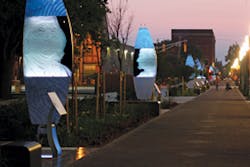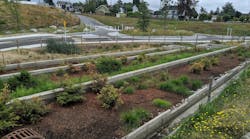How a Cultural Trail Became a Stormwater Management Project
Author Margaret Buranen discusses how Indianapolis’ “Cultural Trail” became a showcase for stormwater management in Part 3 of this continuing series. Through the effective applications of such runoff control methods as stormwater planters as well as other innovative rainwater solutions, the trail has become a remarkable example of stormwater management as well as usable green infrastructure. See full details of this project’s design elements in the segment below.
Taking Runoff Off the Table (Part 3) By Margaret Buranen
Under a consent decree for CSOs, Indianapolis looks for creative solutions.
Indianapolis Cultural Trail
Many cities have difficulty getting suburban residents to come to the urban downtown area. So did Indianapolis, until May 2013. That’s when the final portion of the 8-mile Indianapolis Cultural Trail was dedicated and opened to the public.
Taking Runoff Off the Table (Part 3) By Margaret Buranen
Under a consent decree for CSOs, Indianapolis looks for creative solutions. Indianapolis Cultural Trail Many cities have difficulty getting suburban residents to come to the urban downtown area. So did Indianapolis, until May 2013. That's when the final portion of the 8-mile Indianapolis Cultural Trail was dedicated and opened to the public. [text_ad] "Thousands of people are on the trail every day. People want to be where other people are," says Lauren Day, program manager for the nonprofit organization that manages the trail. The Cultural Trail connects six areas in and near downtown Indianapolis. They are Fountain Square, Indiana Avenue, Massachusetts Avenue, The Canal and White River State Park, the Wholesale District, and Broad Ripple (the latter via a link to the Monan Trail). The project is a remarkable result of citizen initiative and generosity, for the city had no money to fund it. It is a popular destination for both tourists and local residents and a model for connecting various segments of the community and encouraging people to be physically active. "There's an equal split between residents and visitors, as more and more people live and work downtown," says Day. "Indianapolis is a big convention site, and for visitors the trail connects seamlessly to hotels, restaurants, and the convention center." Indy's Cultural Trail is also a fabulous urban green infrastructure stormwater management project. Videos show dedicated bike riders in spandex, casual cyclists on borrowed BikeShare bikes, joggers, walkers, families pushing strollers, and even older citizens holding on to their walkers, all moving along the trail. Whether they are exploring the heart of Indianapolis, heading for a museum or one of the new shops or restaurants the Cultural Trail has spawned, or out for daily exercise, everyone present travels past some of the 25,400 square feet of stormwater planters and rain gardens. Regarding the planters and gardens, Kevin Osburn, RLA, ASLA, principal with Rundell Ernstberger Associates, says, "They're working incredibly well. Some have been in place since 2007. We started construction in 2006 and finished in 2012." He also designed this project. The stormwater planters nearest the streets range from 8 to 9 feet wide. They vary in length from a minimum of 12 or 15 feet to the longest that run the length of a block. The inner planters or rain gardens also vary in size, from 5 to 8 feet wide. The stormwater planters are placed so that water drops into them. "We've gone as deep as 2 feet. We never wanted them to be deeper than 30 inches so that we had to leave guard rails around the planters," explains Osburn. The stormwater planters contain beehive overflow structures to send overflow during heavy rains to the sewer system, but they're designed to capture 99% of rain events. They do not have underdrains. "The soils and subsoils here are very sandy and gravelly," says Osburn. "We're blessed that we have that kind of soil medium to work with." He notes, "Collecting runoff from the streets into the public right of way—that whole concept was new to the city. We worked closely with DPW [the Department of Public Works] to get them on board. We used five different planter designs in the first phase. The city was still apprehensive. But they worked well beyond what anyone expected, so we replicated them. The first phase covered only a half mile. We used that method of collecting stormwater for the next seven and a half miles."“Thousands of people are on the trail every day. People want to be where other people are,” says Lauren Day, program manager for the nonprofit organization that manages the trail.
The Cultural Trail connects six areas in and near downtown Indianapolis. They are Fountain Square, Indiana Avenue, Massachusetts Avenue, The Canal and White River State Park, the Wholesale District, and Broad Ripple (the latter via a link to the Monan Trail).
The project is a remarkable result of citizen initiative and generosity, for the city had no money to fund it. It is a popular destination for both tourists and local residents and a model for connecting various segments of the community and encouraging people to be physically active.
“There’s an equal split between residents and visitors, as more and more people live and work downtown,” says Day. “Indianapolis is a big convention site, and for visitors the trail connects seamlessly to hotels, restaurants, and the convention center.”
Indy’s Cultural Trail is also a fabulous urban green infrastructure stormwater management project. Videos show dedicated bike riders in spandex, casual cyclists on borrowed BikeShare bikes, joggers, walkers, families pushing strollers, and even older citizens holding on to their walkers, all moving along the trail. Whether they are exploring the heart of Indianapolis, heading for a museum or one of the new shops or restaurants the Cultural Trail has spawned, or out for daily exercise, everyone present travels past some of the 25,400 square feet of stormwater planters and rain gardens.
Regarding the planters and gardens, Kevin Osburn, RLA, ASLA, principal with Rundell Ernstberger Associates, says, “They’re working incredibly well. Some have been in place since 2007. We started construction in 2006 and finished in 2012.” He also designed this project.
The stormwater planters nearest the streets range from 8 to 9 feet wide. They vary in length from a minimum of 12 or 15 feet to the longest that run the length of a block. The inner planters or rain gardens also vary in size, from 5 to 8 feet wide.
The stormwater planters are placed so that water drops into them. “We’ve gone as deep as 2 feet. We never wanted them to be deeper than 30 inches so that we had to leave guard rails around the planters,” explains Osburn.
The stormwater planters contain beehive overflow structures to send overflow during heavy rains to the sewer system, but they’re designed to capture 99% of rain events. They do not have underdrains. “The soils and subsoils here are very sandy and gravelly,” says Osburn. “We’re blessed that we have that kind of soil medium to work with.”
He notes, “Collecting runoff from the streets into the public right of way—that whole concept was new to the city. We worked closely with DPW [the Department of Public Works] to get them on board. We used five different planter designs in the first phase. The city was still apprehensive. But they worked well beyond what anyone expected, so we replicated them. The first phase covered only a half mile. We used that method of collecting stormwater for the next seven and a half miles.”


